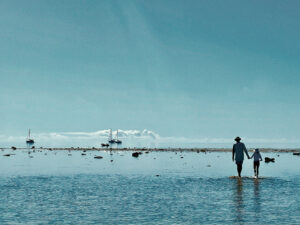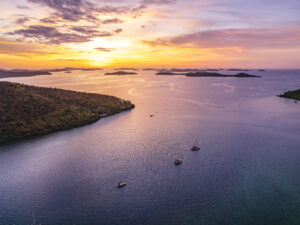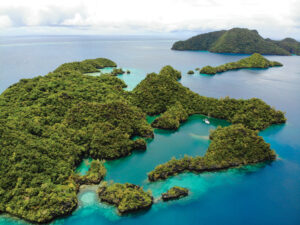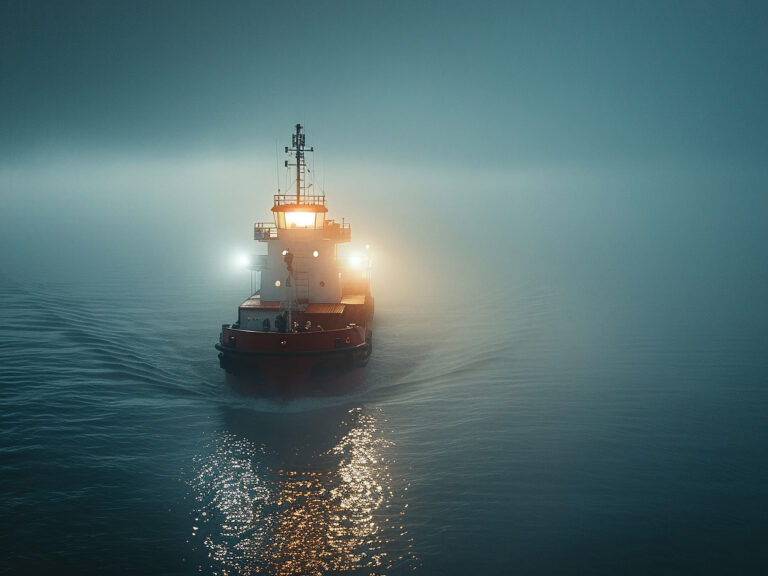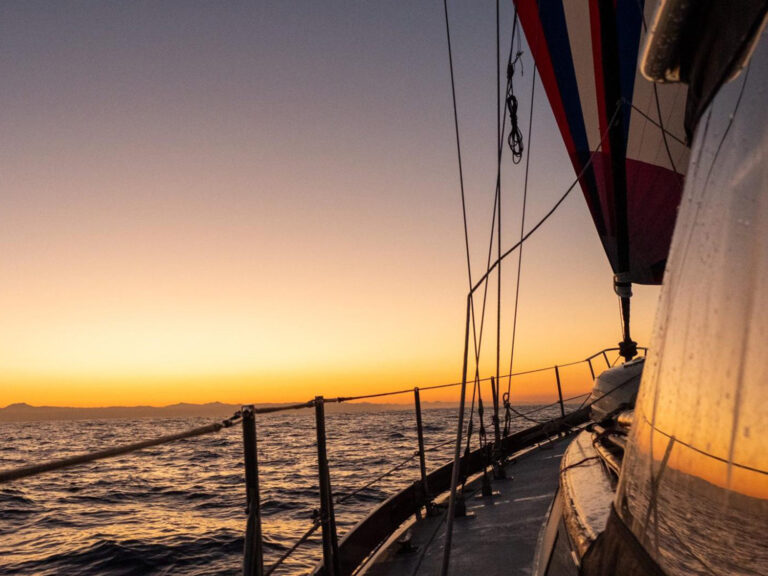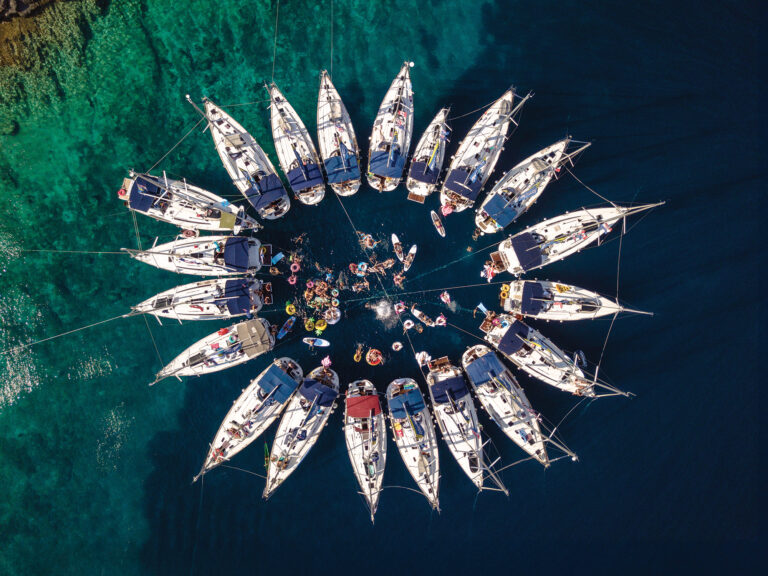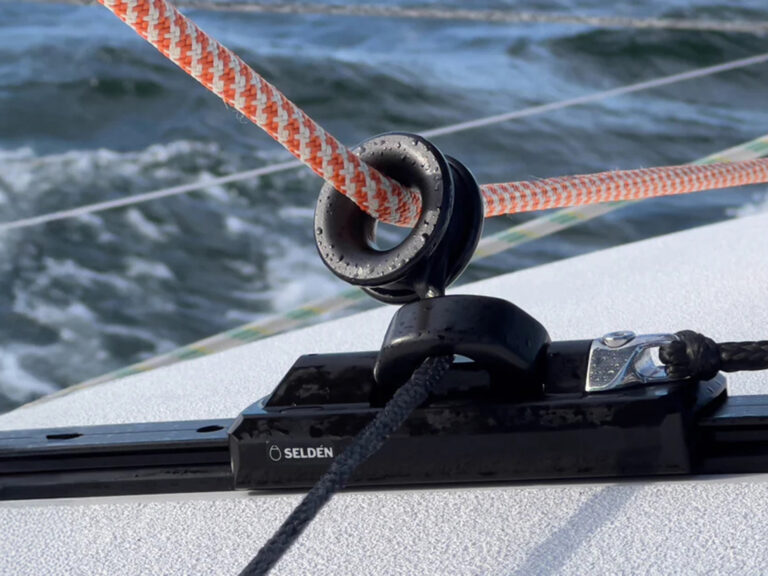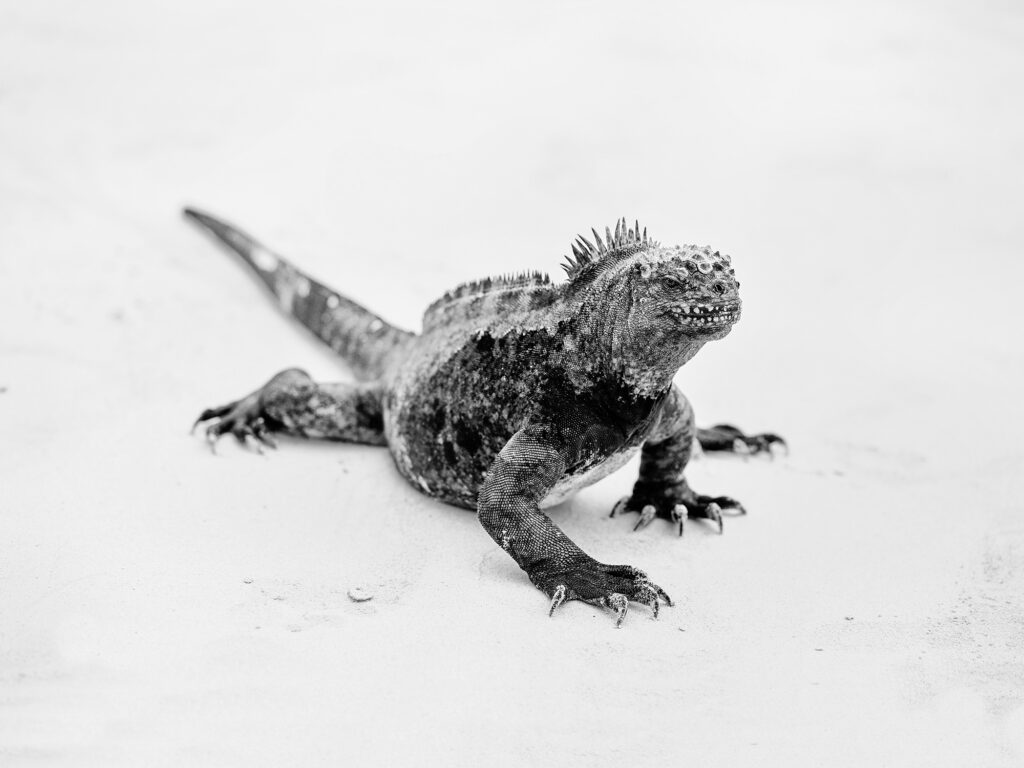
Before we found the Galápagos, the Galápagos found us.
En route from Panama and still 100 miles from San Cristóbal Island—the port of entry for the dozen or so islands of Galápagos National Park and Galápagos Marine Reserve—a trio of red-footed booby birds installed themselves on the starboard bow of Ocean, our Dolphin 460 cruising cat. The ambassadors from the archipelago preened, fished, jostled for position, and slept. When the curtain of dawn revealed the islands on the horizon, we watched our escorts fly ahead.
Ever since 1835, when Charles Darwin (then in his 20s as a botanist aboard HMS Beagle) bundled his observations about the beaks of Galápagos finches into a theory of evolution that outraged the religious establishment, legions of enlightened sailors have been drawn to the islands. Why? Is it the richness of animal life: the birds, sea lions, penguins, marine iguanas and 150-year-old, 900-pound giant tortoises, most of which are unafraid of, and sometimes curious about, visitors? Is it the panorama of volcanoes and lava fields, the whimsical blocks and pinnacles amid a wide sea? Is it these islands’ singular place in history, as a kind of cradle of evolution?
All of the above, despite the slew of official documents and eye-popping fees required to cruise there. We were determined to go, but as we completed another form and authorized another payment, we wondered, Would all of this be worth it?
During our 19-day stay, we decided that the answer was yes. We were privileged to view all manner of marine life, bird life and reptiles, much of it found only in these “Enchanted Islands.” We found workarounds to the three-anchorage restriction that officials placed on Ocean. Sometimes we followed locals to beaches, which they shared with sea lions. We met farmers at the open market, and filled our carryalls with fruit and veggies grown in the highlands. We sipped Galápagos-grown coffee at local cafes, where Ecuadorians grinned at our Spanglish. We sampled waterfront dining and gift shops and, you bet, we got the T-shirt.
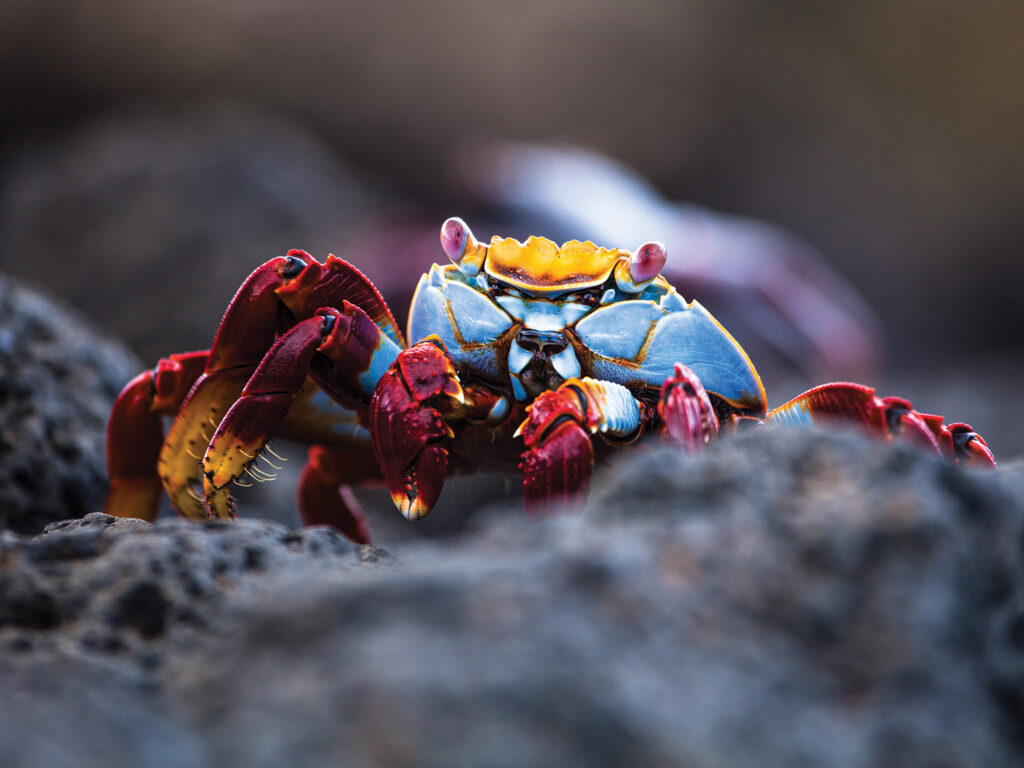
One day, while on a local dive boat speeding along at 20 knots toward a site called Kicker Rock to swim with hammerheads, the captain spotted a red object in the water about 100 yards to port. A life jacket or fishing float? We diverted to take a look, and a burly crewman reached down and snatched the single-use plastic bottle out of the water, muttering “China.”
That’s the way it is in the Galápagos—littering, on land or sea, is not tolerated. Ecuadorians go out of their way to preserve their islands and ocean.
Before we reached Kicker Rock, we anchored in a small cove where the 10 of us snorkelers dinghied ashore with a Galápagos National Park-certified naturalist. We strolled the beach to a saltwater estuary, with frigate birds circling above and land iguanas moving slowly across the sand. Our naturalist—in an easygoing, fun way—explained the world in front of our eyes, including how everything is connected and protected.
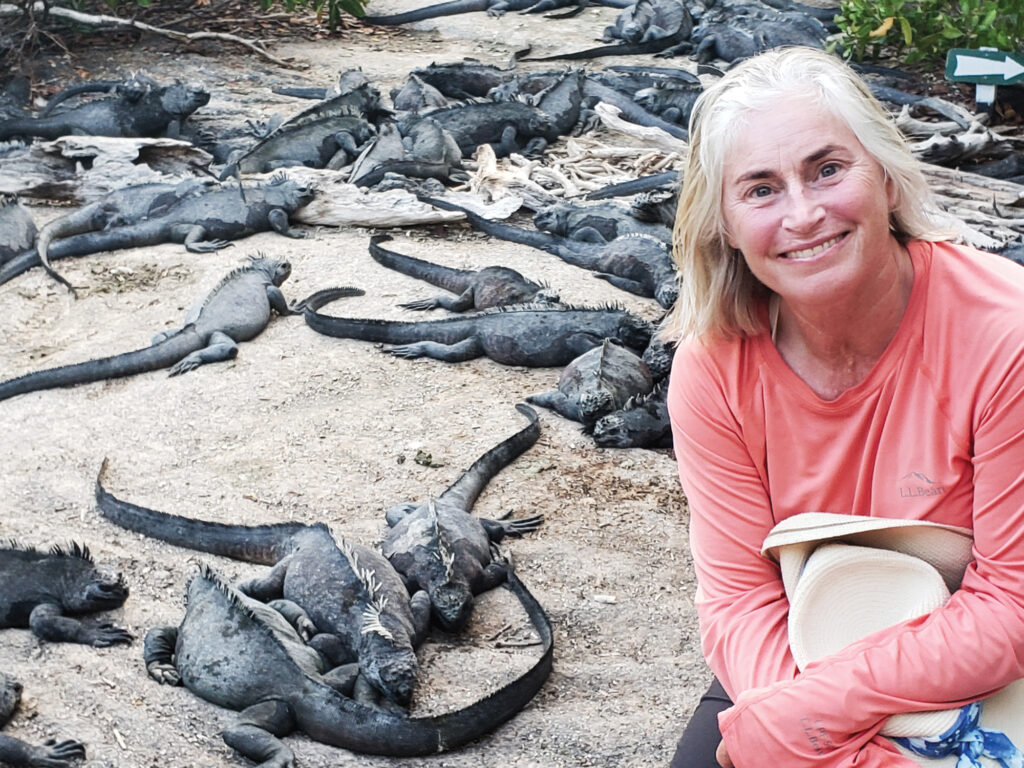
After lunch, we sped off to face the hammerheads, nervously pulled on our wetsuits, and rolled into the water. Swimming against the current swirling around Kicker Rock, we saw reef fish, sea turtles, manta rays and eagle rays—and, 10 feet below our fins, a half-dozen 8-foot hammerheads. They couldn’t have cared less about us as they disappeared into the murk. Forty minutes later, we’d circled the rock and clambered back aboard the dive boat, chattering excitedly. I checked my GoPro: I’d been so mesmerized by the hammerheads that I’d failed to press the shutter.
On another day trip, this time a snorkeling and hiking excursion to Punta Pitt, our group of 10 snorkeled a reefy islet amid cascades of reef fish and adolescent Galápagos sea lions twirling and spinning around us. A large bull, the king of the island, let us know that he was barely tolerating our incursion, with a few officious passes. Later, during a hike ashore on Punta Pitt, our naturalist led us through a geologist’s dream of a lava-sculpted valley and up along a windswept ridge overlooking the sea. We stepped carefully past a pair of blue-footed boobies that were engaged in a courtship dance, the tips of their beaks touching, their blue feet in perfect step.
“Why aren’t they afraid of us?” I asked.
“They know we won’t hurt them,” he said.
On other day trips, we hiked through rainforest in the cool highlands, saw giant tortoises up close, and walked the 5-mile-wide caldera of Sierra Negra, eating our packed lunches on the side of a volcanic cone. Every day there was a “pinch me” moment. When it was time to leave, we concluded that all of us have much to learn from Ecuador’s strict management of the Galápagos Marine Reserve. In our combined 110 years of sailing, the Galápagos coasts are the only ones we’ve seen that are not fouled by plastic trash and dumped fishing gear.
So, we sailed away from the Galápagos somewhat hopeful about the future of the ocean. The archipelago is unforgettable, and it doesn’t have to stand alone.
At press time, Tom and Harriet Linskey were cruising French Polynesia aboard Ocean.
Getting There
The 830-mile passage we made from Panama to the Galápagos has a reputation among cruisers as fluky and frustrating. We asked for a weather forecast from Commanders’ Weather, a passage-routing service we’ve used the past 10 years. The meteorologists replied with a picture of, well, a whole lot of stuff going on. Along our route, we also downloaded weather GRIBs from PredictWind.
In Part One of the passage, boats departing Panama generally get about a day’s worth of tailwinds as the Caribbean’s northeast trade winds pass over Panama and fan out into the Pacific. These winds are variable in strength and direction.
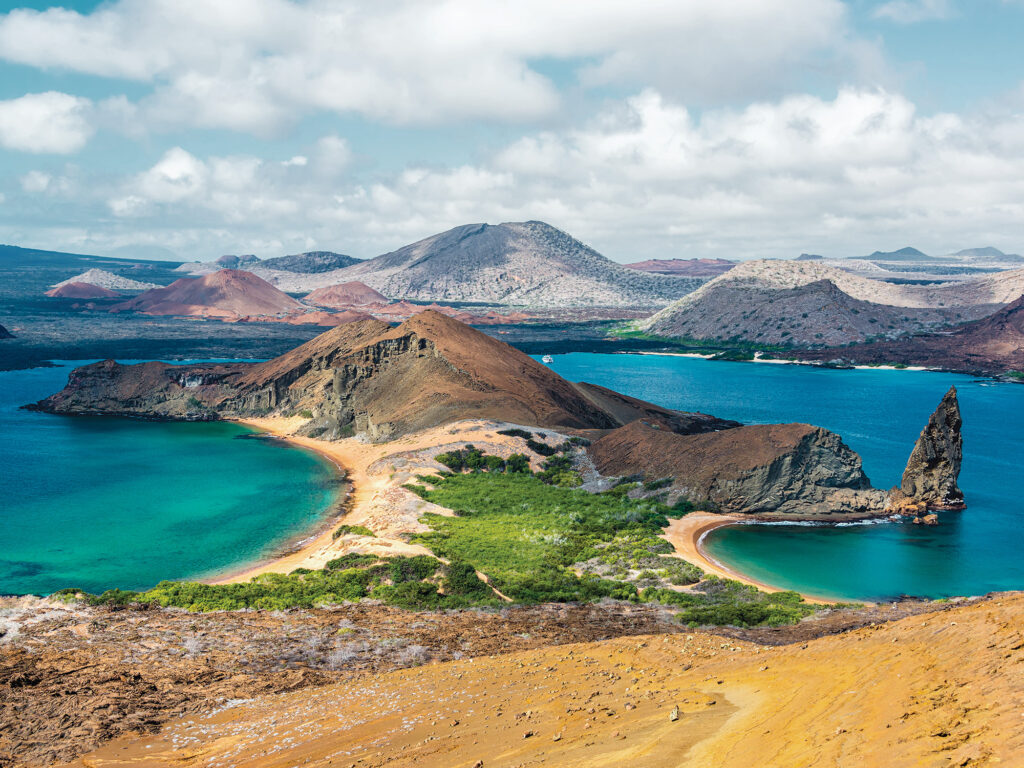
In Part Two, the battle of the winds begins: The calms and squalls of the Intertropical Convergence Zone (ITCZ) wander drunkenly for hundreds of miles between the northeast and southeast trade winds.
In Part Three, the longest leg of the passage, cruisers often face 10- to 20-knot headwinds and chop from the southwest. And the currents of this passage are variable too.
Day One: We made about 6 knots under screecher on a starboard tack in light northerly winds. We got a sampling of freaky currents in the Gulf of Panama, sailing through six distinct current lines that almost seemed to sizzle, with the flat patch after each line feeling like it was lower than the previous patch.
We followed the strategy suggested by Commanders’ Weather to get south into steadier winds and set ourselves up to windward for the long port tack to the Galápagos. With more than 800 miles to go, we were sailing 40 degrees away from the rhumb line to the Galápagos, which took some intestinal fortitude. But the ITCZ is slow, frustrating going, and this end-around is necessary. Soon, we were motoring in flat seas, only a couple of knots of wind, the sky crowded with stars, the Big Dipper astern.
Day Two: The wind, still light, shifted forward into the south. Through no brilliance of our own, we got a 1.5-knot favorable current boost to the south. Ocean motored under mainsail alone at 6 knots on one engine, making 7.5 knots speed over ground. The sea was still board-flat, with the lift of an occasional long-period swell from somewhere way down south. We worried about getting too close to Colombia and Ecuador, and tangled up at night with the big rigs of commercial fishing boats; we penciled in waypoints where we might tack over to port.
Day Three: There’s nothing like the smell of diesel in the morning. We dumped our six jerrycans into the main tank so that our 120-gallon fuel tank was full again. Never had we burned so much diesel with more than halfway still to go in a passage. The wind was continuing light, and a tedious chop had sprung up. Still motorsailing under main only, getting south to the promised land of the southeast trades, we went through the fuel-consumption calculations of using one engine or two, at 1800, 2000, or 2200 rpm.
Day Four: After much debate, and prompted by a sprightly new 10-knot south-southwest wind, we tacked over to port. Now we were heading directly at, or sometimes 10 to 20 degrees below, the Galápagos, 555 miles away. Everything seemed OK, but late in the afternoon, a 20-mile line squall from the northeast slid over the top of our world, complete with a sheet of white-out rain. We motored slowly as a 1.2-knot current boosted us toward San Cristóbal.
Day Five: We did some sailing, interspersed with mostly motorsailing, as the wind flipped from south-southwest to south to south-southeast and back again. The ITCZ did seem to be to leeward of us now. By afternoon, we were sailing closehauled to the Galápagos in 14 knots of wind. Smooth seas, except when politely ruffled by a 1.7-knot favorable current. We turned off the engine, finally.
Day Six: We had only 270 miles to go, still closehauled in 10 to 12 knots of wind, with occasional mainsail-only motorsailing. A posse of orca whales passed by two boat lengths to leeward.
Day Seven: At 0930, with only 123 miles left, we crossed the equator for the fourth time since we’ve been married and voyaging together; we toasted Neptune and Poseidon for taking care of us. We fired up the watermaker, ran two loads of laundry, organized our documents, and stared mesmerized at the volcanic cones and plugs of the Galápagos rising ahead.
Sea Lions on Our Swim Step
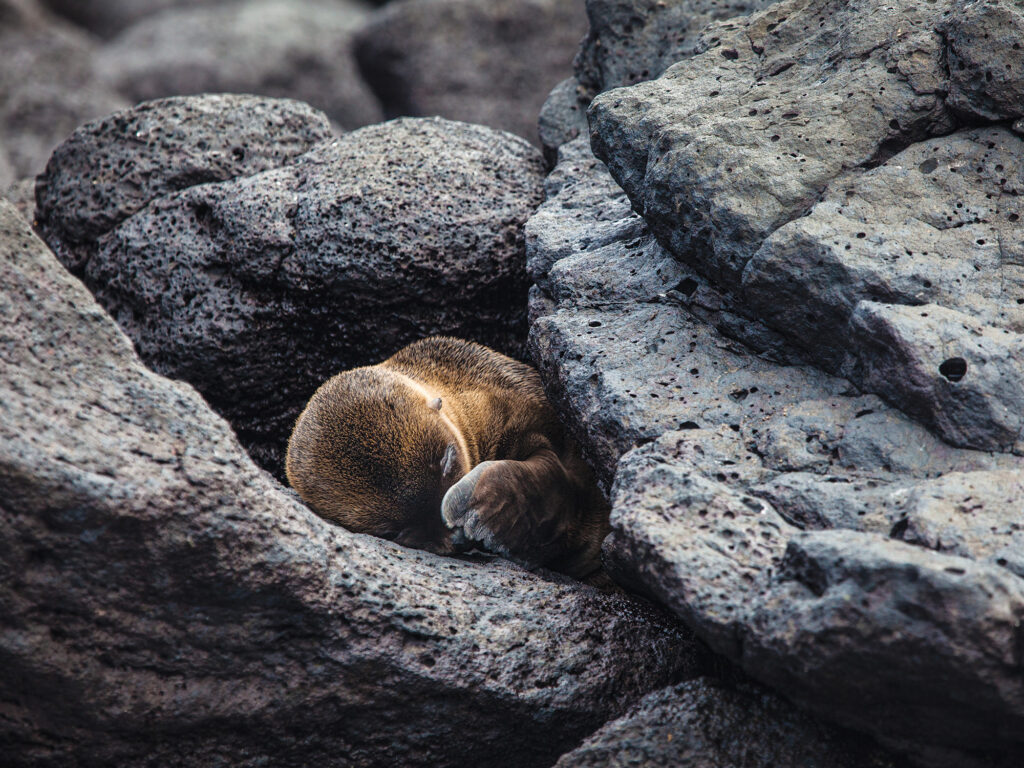
I’d seen sea lions take over a few decrepit fishing boats in a harbor on Isla San Cristóbal— dozens of brown furry bodies were in the cockpit, on the foredeck, up in the wheelhouse. But I never thought it would happen to us.
Then one afternoon, returning from a day of provisioning in town, I found three sea lions aboard Ocean. One, about 280 pounds, was lounging on the cockpit grate. Another, some 180 pounds, was draped across the helm seat. A third, around 150 pounds, was sunning belly up on the starboard side deck.
I used the telescoping deck brush to herd them down the swim steps, where they’d entered, and back into the water. I cleaned up the smears of sea lion body grease, and pee and poo. The cockpit looked like a barbershop floor after a day of buzz cuts. Then I remembered a naturalist saying that Isla San Cristóbal has more than 4,000 sea lions. We love them, but…boundaries. I created a sea lion defense zone by securing the boarding ladder up at a steep angle. I tied a web of dock lines across the sterns, and lashed fenders pointy end out.
It didn’t work.
The challenge only added to the fun—the sea lions were like teenagers jumping a chain-link fence.
There are only a few sea lions on the island of Isla Isabela, we’d been told, so I dismantled the sea lion defense system, and we sailed 40 miles to anchor off Isla Isabela. Soon, a friendly creature began swimming toward us. It was a marine iguana. —TL
Seven-Day Tour: Cruising the “Forbidden” Islands
As cruising sailors, we enjoyed the day-trip snorkeling and hiking excursions, but when I spent a week on the 83-foot, 16-passenger motor vessel Bonita, I experienced the closed-to-cruising-yachts parts of the Galápagos Marine Reserve.
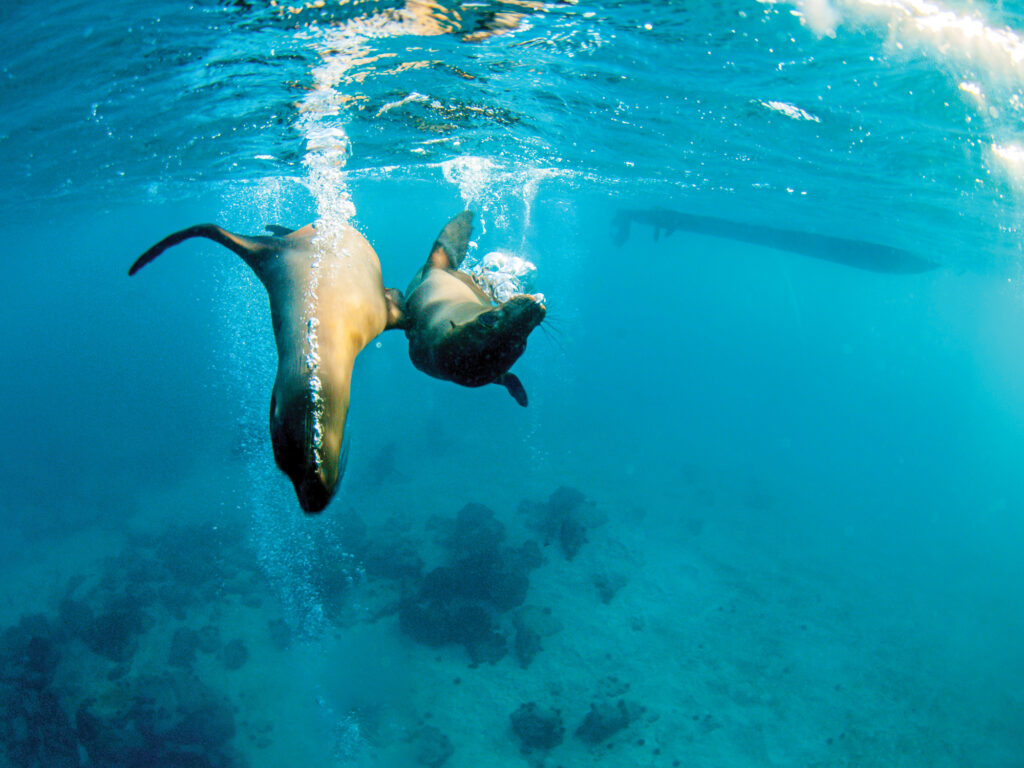
After a day exploring Santiago Island, we departed after dinner to cruise overnight. It was clear and starry, and we could see the glowing red lava fields of Volcan Wolf on the northern edge of Isla Isabela. It was an awesome sight not available to us as cruisers.
The next morning, we awoke to thick fog. Fog at the Equator? Yes, because the northern tip of Isla Isabela swirls with the cold water of the Cromwell Current. As the sun rose and the fog dissipated, a solid rock wall was revealed. We explored life on and under the wall, starting with a dinghy tour of the marine iguanas, flightless cormorants, penguins, sea lions and boobies. After breakfast, we donned our wetsuits to snorkel the cliff face. On a rock covered with red Sally Lightfoot crabs, penguins were grouped at attention while a sea lion draped over the edge, staring at us. The sea lion flipped into the water, and then a flightless cormorant waddled up to take its place.
Underwater, we saw turtles, sea lions, and a school of golden rays that swept through our group. I popped up my head to exclaim my delight, just in time to see a marine iguana paddle nearby.
Touring the Galápagos by small cruise ship means that you slot into the master schedule of the marine park. There are three to four activities every day. Tours keep to the schedule to allow their guests a chance at fantastic encounters, as well as to allow human-free time for the animals. Each day was filled with activities and plenty of exercise, great food, camaraderie, and time to nap and recharge. —HL
Galápagos Regulations: Overboard?
If the thought of seven government officials climbing into your cockpit gives you the butterflies, relax. To enter the Galápagos Marine Reserve, a cruising boat must furnish completed documents, mostly questionnaires about environmental impact. The officials, each with a clipboard and a smile, were practiced and professional.
So were we. While still in Panama, our agent had emailed a folder of documents for us to complete, including a Fumigation Certificate and a Hull Cleaning Certificate. Prior to landfall, we’d done the homework: Ocean sported placards in the required places; we’d reorganized our garbage management; and we’d hove-to in light air outside the Reserve, snorkeling to make sure that Ocean’s hulls were barnacle-free (the Galápagos is on guard against invasive marine species). The one regulation that really rankled us was that cruising boats would be restricted to three anchorages, one each on Isla San Cristóbal, Santa Cruz and Isla Isabela. Our AIS transmitter had to remain on at all times, and diving or fishing from our boat was not permitted. Cruisers can apply to the port captain for permission to visit other islands with a Galápagos Marine Park naturalist for the day, or book day tours with a naturalist. It’s hard to argue with this system’s success: The marine park is a pristine, thriving wilderness area. The archipelago has endured a 400-year human evolution, from slaughtering giant tortoises and sea lions to preserving them. —TL

